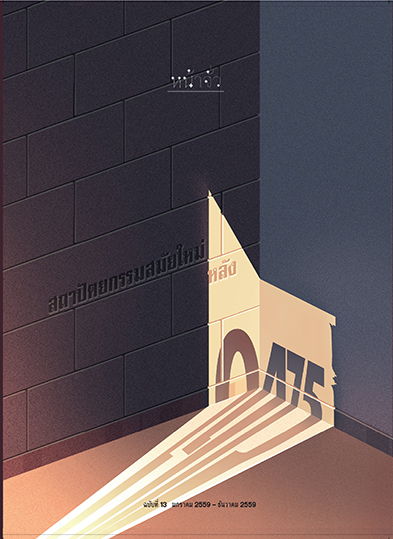ความหมายทางการเมืองและความล้มเหลวของการสื่อความในงานสถาปัตยกรรมคณะราษฎร/ Political Meaning of the People’s Party Architecture and Its Failure
Main Article Content
Abstract
บทคัดย่อ
บทความนี้มุ่งศึกษาสถาปัตยกรรมคณะราษฎรที่สร้างขึ้นในช่วง พ.ศ. 2475-2490 โดยอาศัยกรอบแนวคิดทางสังคมศาสตร์และสถาปัตยกรรมที่ว่า สถาปัตยกรรมเป็นเครื่องมือหรือสื่อที่ใช้ในการถ่ายทอดแนวคิดหรืออุดมการณ์ทางการเมืองของผู้สร้างไปสู่คนทั่วไป
ผลการศึกษาพบว่า หลังจากการปฏิวัติ 2475 คณะราษฎรสร้างสถาปัตยกรรมรูปแบบใหม่เพื่อแสดงออกถึงแนวคิด “ความเป็นไทย” ของคณะราษฎร และลดทอนคุณค่าของแนวคิดว่าด้วย “ความเป็นไทย” ที่ปรากฏในสถาปัตยกรรมสมัยสมบูรณาญาสิทธิราชย์ อย่างไรก็ตามการปะทะแข่งขันกันจบลงด้วยความพ่ายแพ้ของสถาปัตยกรรมคณะราษฎร เนื่องจากปัญญาชนฝ่ายอนุรักษ์นิยมสามารถสร้างวาทกรรมที่ลดทอนคุณค่าของสถาปัตยกรรมคณะราษฎรขึ้นมากดทับแนวคิด “ความเป็นไทย” ในสถาปัตยกรรมคณะ ราษฎรให้เลือนหายไป
Abstract
This article aims to study Khana Ratsadon’s (People’s Party) architecture during B.E. 2475-2490 (1932-1947) based on social scientific and architectural conception of employing architecture as a tool or medium to convey a notion or political ideology of the creator to the people. The study indicated that after the Siamese Revolution of 1932, Khana Ratsadon had created new styles of architecture to introduce their concept of “Thainess” and to diminish the “Thainess” concept presented in architecture during the absolute monarchy period. However, this conflict ended with the defeat of Khana Ratsadon’s architecture. The conservative intellectuals could create discourse, that diminished the value of Khana Ratsadon’s architecture, to suppress and dissolve the “Thainess” concept in Khana Ratsadon’s architecture.


